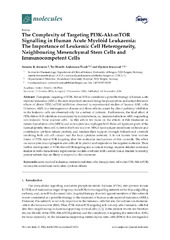| dc.contributor.author | Brenner, Annette | en_US |
| dc.contributor.author | Tvedt, Tor Henrik Anderson | en_US |
| dc.contributor.author | Bruserud, Øystein | en_US |
| dc.date.accessioned | 2019-05-29T09:45:37Z | |
| dc.date.available | 2019-05-29T09:45:37Z | |
| dc.date.issued | 2016-11-11 | |
| dc.Published | Brenner AK, Tvedt THA, Bruserud Ø. The complexity of targeting PI3K-Akt-mTOR signalling in human acute myeloid leukaemia: The importance of leukemic cell heterogeneity, neighbouring mesenchymal stem cells and immunocompetent cells. Molecules. 2016;21(11):1512 | eng |
| dc.identifier.issn | 1420-3049 | |
| dc.identifier.uri | https://hdl.handle.net/1956/19803 | |
| dc.description.abstract | Therapeutic targeting of PI3K-Akt-mTOR is considered a possible strategy in human acute myeloid leukaemia (AML); the most important rationale being the proapoptotic and antiproliferative effects of direct PI3K/mTOR inhibition observed in experimental studies of human AML cells. However, AML is a heterogeneous disease and these effects caused by direct pathway inhibition in the leukemic cells are observed only for a subset of patients. Furthermore, the final effect of PI3K-Akt-mTOR inhibition is modulated by indirect effects, i.e., treatment effects on AML-supporting non-leukemic bone marrow cells. In this article we focus on the effects of this treatment on mesenchymal stem cells (MSCs) and monocytes/macrophages; both these cell types are parts of the haematopoietic stem cell niches in the bone marrow. MSCs have unique membrane molecule and constitutive cytokine release profiles, and mediate their support through bidirectional crosstalk involving both cell-cell contact and the local cytokine network. It is not known how various forms of PI3K-Akt-mTOR targeting alter the molecular mechanisms of this crosstalk. The effect on monocytes/macrophages is also difficult to predict and depends on the targeted molecule. Thus, further development of PI3K-Akt-mTOR targeting into a clinical strategy requires detailed molecular studies in well-characterized experimental models combined with careful clinical studies, to identify patient subsets that are likely to respond to this treatment. | en_US |
| dc.language.iso | eng | eng |
| dc.publisher | MDPI | eng |
| dc.rights | Attribution CC BY | eng |
| dc.rights.uri | http://creativecommons.org/licenses/by/4.0 | eng |
| dc.subject | acute myeloid leukaemia | eng |
| dc.subject | mesenchymal stem cells | eng |
| dc.subject | therapy | eng |
| dc.subject | stem cell niche | eng |
| dc.subject | PI3K-Akt-mTOR | eng |
| dc.subject | monocytes | eng |
| dc.subject | membrane molecules | eng |
| dc.subject | cytokine release | eng |
| dc.title | The complexity of targeting PI3K-Akt-mTOR signalling in human acute myeloid leukaemia: The importance of leukemic cell heterogeneity, neighbouring mesenchymal stem cells and immunocompetent cells | en_US |
| dc.type | Peer reviewed | |
| dc.type | Journal article | |
| dc.date.updated | 2019-01-24T10:41:11Z | |
| dc.description.version | publishedVersion | en_US |
| dc.rights.holder | Copyright 2016 The Author(s) | |
| dc.identifier.doi | https://doi.org/10.3390/molecules21111512 | |
| dc.identifier.cristin | 1399524 | |
| dc.source.journal | Molecules | |

